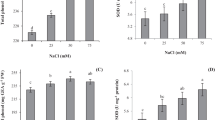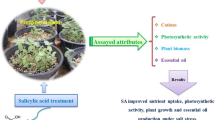Abstract
Abiotic stresses particularly salinity has adverse impact on plants growth and yield. However stress mitigating molecules alleviate plant verdure. Extensive research has revealed several important pharmacological activities of lupeol, a plant triterpenoid. However the interaction of lupeol with plants has not been studied yet. In this study lupeol was applied as salinity stress mitigating agent. Morphological and biochemical (enzymatic and non-enzymatic antioxidants) attributes of Brassica nigra have been analyzed under in vitro conditions. Salt (NaCl) stress (25–100 mg/L) resulted in decrease in root length, shoot length, number of roots and dry weight in dose dependent manner. Application of lupeol alleviated the salinity stress and enhanced the plant length and biomass traits. The free radical scavenging potential and antioxidative response decreased when lupeol was applied along with salt stress as compared to positive control. Phenolics and flavonoids concentrations in plant parts that were observed elevated on salt stress only also decreased when lupeol was applied along with salt. Incorporation of salt in the media resulted in increase of antioxidative enzymes both in shoot and roots however the level of POD and SOD significantly varied on application of lupeol in salt augmented media. The study supports the role of lupeol in protecting the plant from oxidative damage and modulating the stress causing cell redox balance.
Key Message
It is the first report on efficacy of lupeol as salt stress mitigating molecule in plants.




Similar content being viewed by others
Data availability
The data is reported in the manuscript.
References
Albacete A, Ghanem ME, Martínez-Andújar C, Acosta M, Sánchez-Bravo J, Martínez V, Lutts S, Dodd IC, Pérez-Alfocea F (2008) Hormonal changes in relation to biomass partitioning and shoot growth impairment in salinized tomato (Solanum lycopersicum L.) plants. J Exp Bot 59:4119–4131
Albaladejo I, Meco V, Plasencia F, Flores FB, Bolarin MC, Egea I (2017) Unravelling the strategies used by the wild tomato species Solanum pennellii to confront salt stress: from leaf anatomical adaptations to molecular responses. Environ Exp Bot 135:1–12
Ali JS, Ulhaq I, Ali A, Ahmed M, Zia M (2017) Onosma bracteatum wall and Commiphora stocksiana Engl extracts generate oxidative stress in Brassica napus: an allelopathic perspective. Cogent Biol 3(1):1283875
Ali JS, Riaz N, Mannan A, Latif M, Zia M (2021) Antioxidant, antimicrobial, enzyme inhibition, and cytotoxicity guided investigation of Sideroxylon mascatense (A. DC.) TD Penn. leaves extracts. Nat Prod Res 36:1–4
Bartwal A, Mall R, Lohani P, Guru SK, Arora S (2013) Role of secondary metabolites and brassinosteroids in plant defense against environmental stresses. J Plant Grow Reg 32(1):216–232
Bastam N, Baninasab B, Ghobadi C (2013) Improving salt tolerance by exogenous application of salicylic acid in seedlings of pistachio. Plant Grow Regul 69:275–284
Basyuni M, Baba S, Kinjo Y, Oku H (2012) Salinity increases the triterpenoid content of a salt secretor and a non-salt secretor mangrove. Aqu Bot 97(1):17–23
Borsani O, Valpuesta V, Botella MA (2001) Evidence for a role of salicylic acid in the oxidative damage generated by NaCl and osmotic stress in Arabidopsis seedlings. Plant Physiol 126:1024–1030
Bustamante MÁ, Michelozzi M, Barra Caracciolo A, Grenni P, Verbokkem J, Geerdink P, Nogues I (2020) Effects of soil fertilization on terpenoids and other carbon-based secondary metabolites in rosmarinus officinalis plants: a comparative study. Plants 9(7):830
Cárdenas PD, Almeida A, Bak S (2019) Evolution of structural diversity of triterpenoids. Front Plant Sci 10:1523
Choudhury FK, Rivero RM, Blumwald E, Mittler R (2017) Reactive oxygen species, abiotic stress and stress combination. Plant J 90(5):856–867
Dinler BS, Antoniou C, Fotopoulos V (2014) Interplay between GST and nitric oxide in the early response of soybean (Glycine max L.) plants to salinity stress. J Plant Physiol 171:1740–1747
Felipe SHS, Batista DS, Vital CE, Chagas K, Silva PO, Silva TD, Otoni WC (2019) Salinity-induced modifications on growth, physiology and 20-hydroxyecdysone levels in Brazilian-ginseng [Pfaffia glomerata (Spreng.) Pedersen]. Plant Physiol Biochem 140:43–54
Fernández-García N, Hernández M, Casado-Vela J, Bru R, Elortza F, Hedden P, Olmos E (2011) Changes to the proteome and targeted metabolites of xylem sap in Brassica oleracea. Plant Cell Environ 34:821–836
He Y, Zhu ZJ (2008) Exogenous salicylic acid alleviates NaCl toxicity and increases antioxidative enzyme activity in Lycopersicon esculentum. Biol Plant 52:792–795
Hernandez JA, Jiménez A, Mullineaux P, Sevilia F (2000) Tolerance of pea (Pisum sativum L.) to long-term salt stress is associated with induction of antioxidant defences. Plant Cell Environ 23(8):853–862
Husen A, Iqbal M, Aref IM (2017) Plant growth and foliar characteristics of faba bean (Vicia faba L.) as affected by indole-acetic acid under water-sufficient and water-deficient conditions. J Environ Biol 38(2):179
Husen A, Iqbal M, Sohrab SS, Ansari MKA (2018) Salicylic acid alleviates salinity-caused damage to foliar functions, plant growth and antioxidant system in Ethiopian mustard (Brassica carinata A.Br.). Agri Food Sec 7(1):1–14
Inafuku M, Basyuni M, Oku H (2018) Triterpenoid modulates the salt tolerance of lanosterol synthase deficient Saccharomyces cerevisiae, GIL77. Saudi J Biol Sci 25(1):1–9
Kaur H, Bhatla SC (2016) Melatonin and nitric oxide modulate glutathione content and glutathione reductase activity in sunflower seedling cotyledons accompanying salt stress. Nitric Oxide 59:42–53
Koyro HW, Hussain T, Huchzermeyer B, Khan MA (2013) Photosynthetic and growth responses of a perennial halophytic grass Panicum turgidum to increasing NaCl concentrations. Environ Exp Bot 91:22–29
Mittova V, Tal M, Volokita M, Guy M (2003) Up-regulation of the leaf mitochondrial and peroxisomal antioxidative systems in response to salt-induced oxidative stress in the wild salt-tolerant tomato species Lycopersicon pennellii. Plant Cell Environ 26(6):845–856
Munns R, Tester M (2008) Mechanisms of salinity tolerance. Annu Rev Plant Biol 59:651–681
Nahar K, Hasanuzzaman M, Rahman A, Alam MM, Mahmud JA, Suzuki T, Fujita M (2016) Polyamines confer salt tolerance in mung bean (Vigna radiata L) by reducing sodium uptake, improving nutrient homeostasis, antioxidant defense, and methylglyoxal detoxification systems. Front Plant Sci 7:1104
Negrão S, Schmöckel SM, Tester M (2017) Evaluating physiological responses of plants to salinity stress. Ann Bot 119(1):1–11
Park HJ, Kim WY, Yun DJ (2016) A new insight of salt stress signaling in plant. Mol Cells 39(6):447
Qureshi MI, Abdin MZ, Ahmad J, Iqbal M (2013) Effect of long-term salinity on cellular antioxidants, compatible solute and fatty acid profile of Sweet Annie (Artemisia annua L.). Phytochem 95:215–223
Rehman RU, Zia M, Chaudhary MF (2017) Salicylic acid and ascorbic acid retrieve activity of antioxidative enzymes and structure of Caralluma tuberculata calli on PEG stress. Gen Physiol Biophy 36:167–174
Rengasamy P, Olsson KA (1993) Irrigation and sodicity. Aust J Soil Res 31:821–837
Sharma N, Palia P, Chaudhary A, Verma K, Kumar I (2020) A review on pharmacological activities of lupeol and its triterpene derivatives. J Drug Del Therap 10(5):325–332
Singh B, Sharma RA (2015) Plant terpenes: defense responses, phylogenetic analysis, regulation and clinical applications. 3 Biotech 5(2):129–151
Srivastava AK, Srivastava S, Lokhande VH, D’Souza SF, Suprasanna P (2015) Salt stress reveals differential antioxidant and energetics responses in glycophyte (Brassica juncea L.) and halophyte (Sesuvium portulacastrum L.). Front Environ Sci 3:19
Szakiel A, Pączkowski C, Pensec F, Bertsch C (2012) Fruit cuticular waxes as a source of biologically active triterpenoids. Phytochem Rev 11(2–3):263–284
Ullah A, Romdhane L, Rehman A, Farooq M (2019) Adequate zinc nutrition improves the tolerance against drought and heat stresses in chickpea. Plant Physiol Biochem 143:11–18
Vamerali T, Saccomani M, Bona S, Mosca G, Guarise M, Ganis A (2003) A comparison of root characteristics in relation to nutrient and water stress in two maize hybrids. Plant Soil 255:157–167
Yousuf PY, Ahmad A, Aref IM, Ozturk M, Ganie AH, Iqbal M (2016) Salt-stress-responsive chloroplast proteins in Brassica juncea genotypes with contrasting salt tolerance and their quantitative PCR analysis. Protoplasma 253(6):1565–1575
Zafar H, Gul FZ, Mannan A, Zia M (2020) ZnO NPs reveal distinction in toxicity under different spectral lights: an in vitro experiment on Brassica nigra (Linn) Koch. Biocat Agric Biotechnol 27:101682
Zhang M, Smith JAC, Harberd NP, Jiang C (2016) The regulatory roles of ethylene and reactive oxygen species (ROS) in plant salt stress responses. Plant Mol Biol 91(6):651–659
Zia M, Zafar H, Gul FZ, Abbasi BH, Rizvi ZF, Mannan A (2021) Synergistic influence of CuO nanoparticles and spectral lights transforms biomass, antioxidative response, and antioxidants in Brassica nigra. Plant Cell Tissue Organ Cult PCTOC 145(2):261–274
Funding
The authors have not disclosed any funding.
Author information
Authors and Affiliations
Contributions
MZ conceived the idea and proof read the manuscript. JSA and SH performed the experiment. AS did the statistical analysis. BHA supervised the work and proof read the manuscript.
Corresponding author
Ethics declarations
Conflict of interest
All authors declare no conflict of interest.
Additional information
Communicated by Alison M. R. Ferrie.
Publisher's Note
Springer Nature remains neutral with regard to jurisdictional claims in published maps and institutional affiliations.
Supplementary Information
Below is the link to the electronic supplementary material.
Rights and permissions
Springer Nature or its licensor (e.g. a society or other partner) holds exclusive rights to this article under a publishing agreement with the author(s) or other rightsholder(s); author self-archiving of the accepted manuscript version of this article is solely governed by the terms of such publishing agreement and applicable law.
About this article
Cite this article
Zia, M., Ali, J.S., Hanif, S. et al. Lupeol, a plant triterpenoid mitigates salt induced stress: growth and antioxidative response of Brassica nigra under in vitro condition. Plant Cell Tiss Organ Cult 154, 327–335 (2023). https://doi.org/10.1007/s11240-022-02405-2
Received:
Accepted:
Published:
Issue Date:
DOI: https://doi.org/10.1007/s11240-022-02405-2




